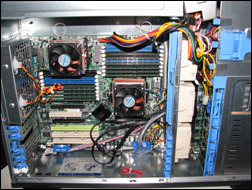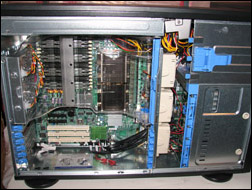Low Power Server CPU Shoot-out
by Jason Clark & Ross Whitehead on July 17, 2007 12:15 AM EST- Posted in
- IT Computing
Test Setup
Both of our systems are in an identical chassis, with identical power supplies. The systems differ only in the motherboard/CPU/memory and in their fan setup. Intel Xeon systems typically use a ducted system as you can see below, whereas AMD uses a conventional heatsink w/fan.
Socket-F System
The Socket-F system has two 2.6GHz (2218/2218HE) processors mounted on a Tyan S3992 main board, with 8x1GB of DDR2-667 OEM memory. Internal cooling consists of five 3.5" fans and two CPU fans. Internal storage is provided by one WD1600YD hard drive, which is where the OS is installed.
Woodcrest System
The Woodcrest system is configured with two 2.33GHz Xeon 5140/5148 processors, seated in a SuperMicro X7DBE+. The Woodcrest system is outfitted with 8x1GB 667 MHz OEM FB-DIMMs. Internal cooling consists of five 3.5" fans, with plastic ducting directing airflow across the CPUs and FB-DIMMs (shown below). Internal storage once again comes from one WD1600YD hard drive with the OS installed.
RAID Storage
LSI Logic 8480E MegaRaid Controller
Promise VTRAK J300s SAS Chassis
12 x 146GB Fujitsu 15,000 RPM SAS Drives configured in RAID 0
Operating System/Software
Windows 2003 Enterprise SP2 x64
SQL 2005 Enterprise x64 SP2
Both of our systems are in an identical chassis, with identical power supplies. The systems differ only in the motherboard/CPU/memory and in their fan setup. Intel Xeon systems typically use a ducted system as you can see below, whereas AMD uses a conventional heatsink w/fan.
Socket-F System
The Socket-F system has two 2.6GHz (2218/2218HE) processors mounted on a Tyan S3992 main board, with 8x1GB of DDR2-667 OEM memory. Internal cooling consists of five 3.5" fans and two CPU fans. Internal storage is provided by one WD1600YD hard drive, which is where the OS is installed.
Woodcrest System
The Woodcrest system is configured with two 2.33GHz Xeon 5140/5148 processors, seated in a SuperMicro X7DBE+. The Woodcrest system is outfitted with 8x1GB 667 MHz OEM FB-DIMMs. Internal cooling consists of five 3.5" fans, with plastic ducting directing airflow across the CPUs and FB-DIMMs (shown below). Internal storage once again comes from one WD1600YD hard drive with the OS installed.
 Socket F Server |
 Woodcrest Server |
RAID Storage
LSI Logic 8480E MegaRaid Controller
Promise VTRAK J300s SAS Chassis
12 x 146GB Fujitsu 15,000 RPM SAS Drives configured in RAID 0
Operating System/Software
Windows 2003 Enterprise SP2 x64
SQL 2005 Enterprise x64 SP2










27 Comments
View All Comments
mikepers - Friday, July 20, 2007 - link
So, quick rough calculation. Assuming electricity costs 10 cents per KWH then I believe that with the AMD chip you're saving 80 watts x 24 hrs day x 365 / 1000 x .10 = about $70 per year. (at idle)One thing not addressed in this article: Assuming a large server farm, what are your infrastructure savings? How much do you save in cooling that infrastructure. How much do you save because you can buy less generating capacity for when you have power outages? Any thoughts?
Last comment, for all the info in the article the most significant statistic for a large server farm is performance per watt. How much work can the farm do given the resources it consumes. In that respect it looks like AMD wins but not by as much as the initial difference in power consumption would have you believe.
bruce24 - Tuesday, July 17, 2007 - link
You can buy 2GB and 4GB FB-DIMMS, yes they are a bit more expensive, but if you interested in power savings and an intel DP server, they are the way to do.I've love to see the numbers if you replaced the 8 1GB DIMMs with 4 2GB or even better 2 4GB DIMMs.
Justin Case - Tuesday, July 17, 2007 - link
Then why not compare them to 2GB and 4GB registered (non-FB) DDR2 modules? Micron has been making them since 2004 (well, they announced them, at least). There must be other companies making / selling them these days (I'm pretty sure Infineon and Samsung are).A quick search turned up Kingston's D51272F51 module (not sure who makes the chips). Not cheap, though (almost $900).
I think I even remember seeing some reference to an 8GB DDR2 DIMM, but it could have been just a kit (4+4).
IIRC, FB-DIMM power consumption is roughly 80% higher than regular registered DIMMs.
jpeyton - Tuesday, July 17, 2007 - link
2GB FB-DIMMs are feasible, since they are roughly 2X the price of 1GB modules. 4GB FB-DIMMs are roughly 11.5X more expensive than a 1GB module.
That might lower power consumption by a noticeable amount, but nothing significant enough to erase the huge gap between platforms.
Intel really needs to do more work on platform engineering; their gains in CPU efficiency are entirely erased (and then some) by some foolish choices (like going the FB-DIMM route).
It may not affect the little guys, but companies with server farms or HPC take platform efficiency very seriously (which is why companies like Cray and Sun are adamant about sticking with AMD).
TA152H - Tuesday, July 17, 2007 - link
"Intel really needs to do more work on platform engineering; their gains in CPU efficiency are entirely erased (and then some) by some foolish choices (like going the FB-DIMM route). "You're kidding, right? They made a conscious choice to use FB-DIMMS because of the benefits of it, and considered them more important than the negatives. It certainly isn't because they didn't have engineering resources for the platform, because that's exactly what they used to create the FB-DIMM platform. You might not agree with their choice of trade-offs, but using normal DDR2 or DDR3 would be comparitively easy considering they already have chipsets that support it.
I'm mixed on FB-DIMMS. There's a lot of bad, but there's a lot of good too. I'll agree with you in one way, they do need to provide people a choice. So, in that sense, I don't think they've done a great job on their platform. FB-DIMMs are certainly the best choice in some situations, and certainly not in others. People should decide based on their situation.
Alyx - Tuesday, July 17, 2007 - link
I believe intel processors still hold the edge on performance per watt. In these tests the AMD system had higher performance per watt because of the intel ram. I'd be interested in an intel system with standard ram to get a closer comparison of just the processors. Are intel processors with standard ram uncommon?It is illogical that a faster higher performing processor, that does more clock few clock than AMD, which also runs at lower watts would have less performance per watt than AMD.
Interesting read, I learned a bit from it. Cheers.
TA152H - Tuesday, July 17, 2007 - link
Intel servers currently support FB-DIMMs, so that is the platform that must be tested.Also keep in mind you can't measure processors alone for power, although most sites do this incorrectly. AMD processors simply do more, they have a memory controller. So, all things being equal, a processor with a memory controller will use more power, but at the same the chipset would use less. Of course, not everything is ever equal, but my point is, even seemingly simple comparisons like CPU to CPU aren't quite so simple.
I have read that Intel may be backing off of FB-DIMMS, but until they do, and these folks are testing servers, it's absolutely valid data because that's what you're getting if you buy an Intel based solution. A lot of people have problems with Intel choosing this type of memory, so they might back off of it, or at least offer both. FB-DIMMS obviously have advantages too, so giving people a choice might make a lot of sense.
BPB - Tuesday, July 17, 2007 - link
If energy savings is your aim, and your organization is a large one, then check out http://www.internetnews.com/storage/article.php/36...">this article from last month.http://www.internetnews.com/storage/article.php/36...">http://www.internetnews.com/storage/article.php/36...
brshoemak - Tuesday, July 17, 2007 - link
Normally I'm not an editor but:[under the Test Setup configurations]
i'm assuming it's two hard drives? or am I missing something because it's early
Jason Clark - Tuesday, July 17, 2007 - link
Fixed.